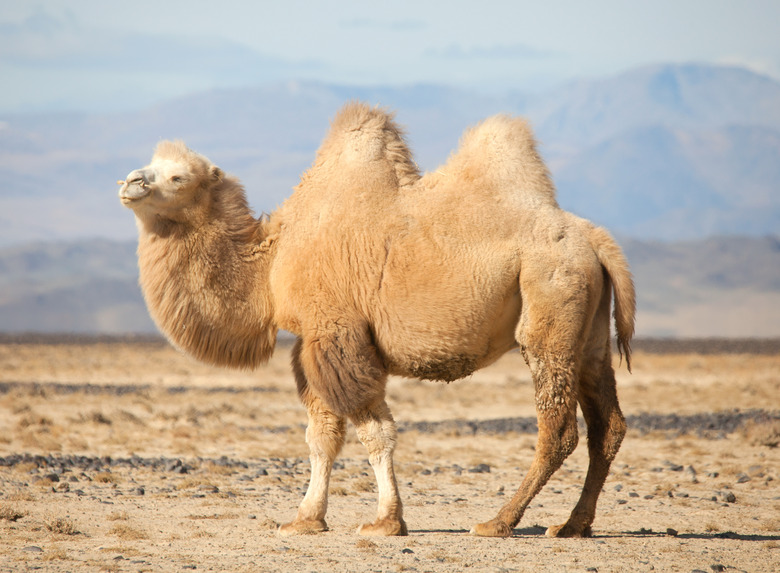How Do Plants & Animals Adapt To The Desert?
The ability to adapt to arid conditions can mean the difference between life or death for animals and plants that live in the desert. Some animals burrow deep underground in the heat of the day, lie in the shade until late afternoon or early evening, or have evolved salt glands, which allow their bodies to secrete salt but not sweat so they retain water. Most deserts have dry, arid climates with little to no rain, so every living organism that lives there must find a way to adapt, survive and thrive, or die.
Nocturnal Animals
Nocturnal
Animals
At night, the desert comes alive. A universal adaptation of desert living begins with an upside-down day. Instead of sleeping at night, nocturnal animals sleep during the hottest part of the day, only to take up their business of hunting food during the graveyard shift. By sleeping in the day, usually in the shade beneath an outcropping of rocks, in a burrow dug into the cool underground or beneath the shade of a creosote bush, they preserve their body's water. This applies to mammals, insects and reptiles of the desert.
Water Storage
Water
Storage
Native Americans familiar with desert life could always find water when it couldn't be found on land, by slicing open a barrel cactus or taking pieces of the saguaro cactus flesh and consuming it. Saguaro cactus (Carnegiea gigantea) can grow to over 40 feet tall and live for up to 150 years in conditions that would kill other plants. This tree-like pillar cactus with arms that shoot out at 90-degree angles before growing vertically, and seen in many western movies of yesteryear, survives and thrives in the arid desert because it stores enormous amounts of rainwater inside its thick, fleshy arms and body, using it slowly. Many cacti visibly expand during the rainy season, which also helps them to grow. The saguaro cactus also produces an edible fruit that some native tribes made into a fermented beverage for rainfall ceremonies.
Physical Adaptations
Physical Adaptations
Camels evolved and physically adapted to hot desert days and cold desert nights in multiple ways. The camel's hump doesn't store water, as many people think; it stores fat. The hump's fat provides the camel with a source of energy for long desert journeys. As the fat is used, it creates water as a by-product, which adds to the animal's supply of water through its bloodstream.
Camels don't sweat as much as humans do, and at night, their metabolism slows way down to help preserve water as well. The heavy fur on their bodies acts as an insulator against heat as well as a blanket against a desert's extreme winter cold. With extra-dry nasal passages and large nostrils closed and opened at will, camels condense moisture by cooling incoming air. Because of all the desert sand that gets blown about, camels have three eyelids, and long curly eyelashes that protect their eyes from the sand.
Desert Greasewood
Desert Greasewood
The desert greasewood or creosote bush (Larrea tridentata) adapted to life in the desert so well that there is one in California's Mojave Desert that is nearly 12,000 years old. The leaves contain a waxy substance that helps to keep out the sun's ultraviolet rays and preserve water, but once it does rain, the waxy material gives off a fragrance that many desert dwellers forever associate with the smell of rain. When a stem or branch of the plant dies, it sends up a new clone that grows in a circle surrounding the parent plant. Each part of the plant lives only about a century, but that cloning ability lets the entire plant structure stay alive for centuries.
References
- Center for Educational Technologies: Desert: Animals
- Arizona-Sonora Desert Museum: Plant Fact Sheet: Saguaro Cactus
- Indiana Public Media: Camels
- University of Arizona: The Creosote Bush
- AZCentral: Ask Clay: Arizona Smells Wonderful After Rain
- AZCentral: Saguaro-Fruit Harvest Carries on Arizona Tribal Tradition
Cite This Article
MLA
Brenner, Laurie. "How Do Plants & Animals Adapt To The Desert?" sciencing.com, https://www.sciencing.com/do-plants-animals-adapt-desert-6516007/. 17 April 2018.
APA
Brenner, Laurie. (2018, April 17). How Do Plants & Animals Adapt To The Desert?. sciencing.com. Retrieved from https://www.sciencing.com/do-plants-animals-adapt-desert-6516007/
Chicago
Brenner, Laurie. How Do Plants & Animals Adapt To The Desert? last modified March 24, 2022. https://www.sciencing.com/do-plants-animals-adapt-desert-6516007/
